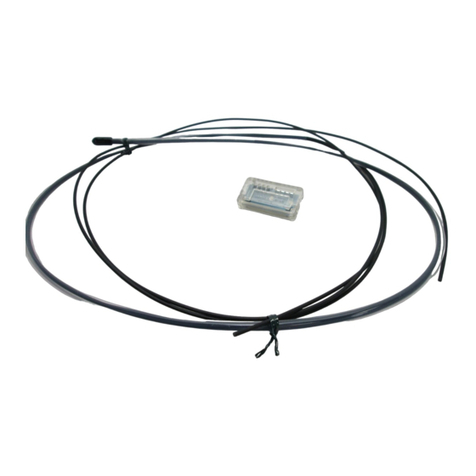P. 41l
The amplifier of LS-400 series features and settings are generally classified into two main modes; the
‘
NAVI
’
mode
for items and settings that are frequently reconfigured, and the
‘
PRO
’
mode that contains more detailed settings.
Diagram of Functions and Settings
2-1. Diagram of Functions and Settings
2
NAVI
mode
PRO
mode
mFor output 1
Refer to
p. 53l.
mFor
output 2
Refer to
p. 55.
PRO5
PRO4
PRO3
PRO2
PRO1
PRO6
This indicates normal sensing
operation. The threshold value
can be fine-adjusted as well.
Run
RUN
Allows various detailed settings to be
configured, such as optical communications,
save / load and other settings.
Pro
PRO
Shows stored settings for functions.
(Refer to p. 10.)
Custom
CUST
The threshold value can be set by utilizing
either ‘2-level / limit / full-auto teaching’. When
the sensor is in window comparator / hysteresis
mode, the threshold value can be set by either
‘1-level / 2-level / 3-level teaching’. When using
rising / trailing differential mode, ‘span
adjustment’is carried out. (Refer to p. 11.)
Teaching
TEACH Sets output operation either
Light-ON, or Dark-ON. (Refer to
p. 22.)
L-ON / D-ON
L/D ON
Configures operation and period
of the timer. (Refer to p. 23.)
Timer
TIMER
Switches among response
times. (Refer to p. 25.)
Response time change
Sets hysteresis. (Refer to p. 26.)
Hysteresis
Shifts the ‘threshold value’by a
certain percentage increment in
‘limit teaching’. (Refer to p. 27.)
Shift
Selects laser emission to
execute or halt. (Refer to p. 29.)
Emission halt
Sets the digital display to turn
ON / OFF. (Refer to p. 34.)
ECO mode setting
Selects to display peak / bottom
values in the hold condition or
peak / bottom values in the digital
display refleshing condition.
(Refer to p. 35.)
Period hold
Saves current incident light
intensity. (Refer to p. 36.)
Sets the viewing orientation of the
digital display. (Refer to p. 33.)
Display turning
P. 30l
This selects whether the digital display
is fixed at digits, % or peak hold / bottom
hold display, or whether the display can
be selectable. (Refer to p. 32.)
Display switching
This simultaneously displays the saved incident
light intensity and the current incident light
intensity for checking things such as drops in
incident light intensity. (Refer to p. 37.)
Stored value comparison
P. 38l
Loads configuration setting from the data
bank. Select only one amplifier to load or all
amplifiers connected on the right side of the
main unit to load in a single step by using
optical communications. (Refer to p. 39.)
Data bank load
Saves configuration setting from the data
bank. Select only one amplifier to save or all
amplifiers connected on the right side of the
main unit to save in a single step by using
optical communications. (Refer to p. 40.)
Data bank save
Using optical communications,
configuration settings from the
main unit are copied to units
connected on the right side of
the main unit, in a single step.
(Except data bank load / save,
0-adjust function setting and
transmission change to permit /
not to permit.) (Refer to p. 42.)
Copy
mCable type only
mCable type only
Allows not to save the threshold
value, by teaching via external
input, in EEPROM. (Refer to p. 45.)
Backup setting
P. 46l
Allows basic configuration
information to be set in a single
step, by inputting a 8-digit code.
(Refer to p. 48.)
Coding
Forces the numerical value for
incident light intensity to ‘0’on the
digital display. (Refer to p. 49.)
0-adjust setting
All settings, except for data
bank, revert to factory settings.
(Refer to p. 50.)
Reset
Sensing mode that cancels out
slight changes in light intensity so
that only sudden increases in
incident light intensity are sensed.
Rising differential mode
Judges if set two threshold values
are within the required range or not.
This can be selected in 1-level /
2-level / 3-level teaching.
Window comparator mode
Sets a threshold value for ON /
OFF operation.
Normal mode
Changes hysteresis to ignore
small change of incident light
intensity. This can be selected in
1-level / 2-level / 3-level teaching.
Hysteresis mode
Sensing mode that cancels out
slight changes in light intensity so
that only sudden decreases in
incident light intensity are sensed.
Trailing differential mode
Set to OFF when not using
output 2.
Output 2 OFF
Sets receiving light sensitivity
in 3 level (U-LG mode: 4-level).
(Refer to p. 28.)
M.G.S.
Using external input wire,
‘emission halt’, ‘full-auto
teaching’or ‘limit teaching’is
selected. (Refer to p. 44.)
Selects a function in CUSTOM
mode to display. (Refer to p. 51.)
CUSTOM mode display
Allows to ignore copy / load /
save operations in a single step
used by optical communications.
(Refer to p. 43.)
Transmission change
to permit / not to permit
External input
switch setting
() ()
P. 24l
P. 52l
Current value
storage




























